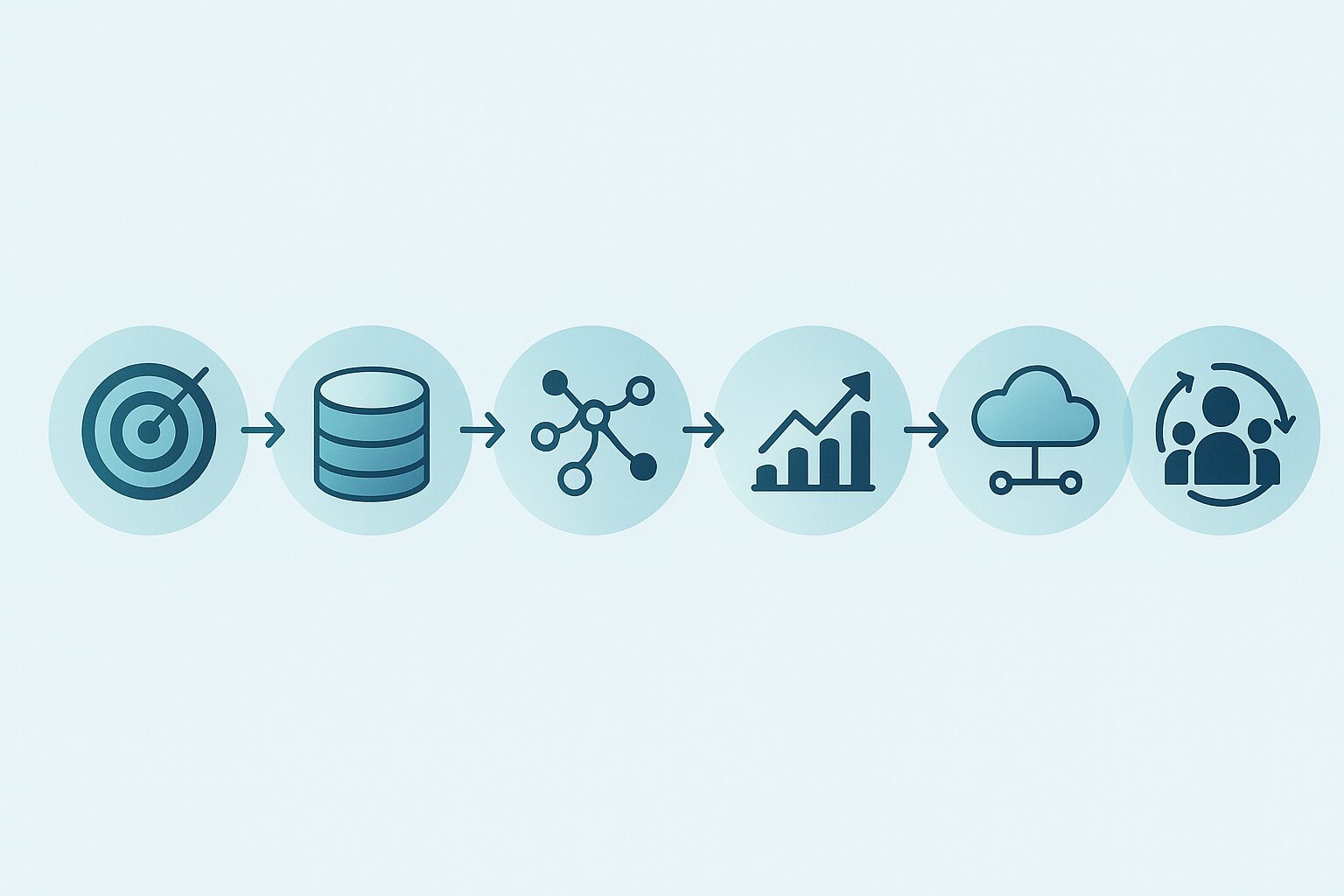Introduction
Many AI initiatives struggle or fail—not due to poor models, but due to vague problem statements, poor data understanding, or lack of business alignment. Without a clear structure, teams risk building technically sound models that never deliver value. This article presents a strategic, six-step framework to help AI Solutions Managers structure AI use cases that align with business goals, ensure feasibility, and drive adoption. Whether you’re building a readmission predictor or a compliance automation tool, this framework ensures you’re solving the right problem the right way.
1. Problem Framing
Strategic Role
Problem framing is the foundation. It defines the business goal, identifies the decision point, and sets the success criteria. Poor framing leads to misaligned solutions, regardless of technical excellence.
Key Questions
-
What’s the business goal or pain point?
-
What KPI are we trying to optimize?
-
What decisions will the model inform?
Example
Healthcare: Reducing 30-day readmission rates.
KPI: Readmission %.
Decision: Should a patient be flagged for post-discharge intervention?
Pitfalls to Avoid
-
Vague objectives like “use AI to improve care.”
-
No measurable KPI.
-
Confusing correlation with causation.
Tips/Tools
-
Use problem-framing canvases like AI Canvas (IDEO, Microsoft).
-
Align with line-of-business stakeholders early.
2. Data Evaluation
Strategic Role
Data shapes feasibility and scope. Evaluate data quality, availability, and labeling needs before modeling begins.
Key Questions
-
What data exists today?
-
Structured, unstructured, or both?
-
Is it labeled, clean, and complete enough?
Example
Retail: Predicting next-week demand per SKU-store.
Data: Transaction logs (structured), promo ads (unstructured), weather feeds.
Pitfalls to Avoid
-
Assuming more data = better data.
-
Ignoring data freshness or granularity.
-
Misjudging labeling effort for supervised learning.
Tips/Tools
-
Run quick EDA (Exploratory Data Analysis) using Pandas, SQL, or notebooks.
-
Leverage data profiling tools like Great Expectations or Monte Carlo.
3. Modeling Feasibility
Strategic Role
This step aligns the problem with the right learning paradigm—supervised, unsupervised, NLP, etc.—and sets realistic expectations.
Key Questions
-
What type of model fits best?
-
Are labels available or feasible to obtain?
-
Do we need embeddings, annotations, or domain models?
Example
Compliance: Automating fraud detection in expense claims.
Fit: Supervised + NLP.
Need: Annotated historical claims + OCR pipeline.
Pitfalls to Avoid
-
Overengineering with deep learning when simpler models work.
-
Choosing models without understanding business constraints (e.g., interpretability).
Tips/Tools
-
Start with model cards to evaluate trade-offs.
-
Use low-code AutoML tools for prototyping (H2O.ai, Azure AutoML).
4. Value Estimation
Strategic Role
Quantifies business impact to prioritize high-ROI projects and justify investments.
Key Questions
-
What is the business impact if solved?
-
Will it reduce costs, increase revenue, or lower risk?
-
What’s the time to value?
Example
Logistics: Route optimization to reduce fuel use.
Projected Impact: $1M/year savings per 5% efficiency gain.
Time to Value: 10-week pilot.
Pitfalls to Avoid
-
No baseline for comparison.
-
ROI framed only in technical terms.
-
Ignoring TCO (Total Cost of Ownership).
Tips/Tools
-
Use a business case calculator.
-
Partner with finance to validate estimates.
5. Deployment Path
Strategic Role
Translates models into operational systems. Deployment must align with user workflows and latency needs.
Key Questions
-
Real-time or batch?
-
Cloud, on-prem, or edge?
-
What UI/workflow changes are needed?
Example
Insurance: Underwriting risk scoring model.
Deployment: Batch scoring via API, integrated with internal CRM.
Pitfalls to Avoid
-
“Throwing models over the wall” to engineering.
-
No clarity on where or how predictions are consumed.
Tips/Tools
-
Build MLOps pipelines using MLflow, FastAPI, or Docker.
-
Conduct user journey mapping to ensure integration into decision loops.
6. Change Management
Strategic Role
Drives user adoption by aligning people, processes, and policies. Even the best model fails if no one uses it.
Key Questions
-
Who needs buy-in?
-
What training or process changes are required?
-
How will feedback and iteration work?
Example
Finance: Automating invoice classification.
Required: Finance team training, policy revision on automation QA, feedback loop to update model monthly.
Pitfalls to Avoid
-
No champion in the business unit.
-
Ignoring frontline resistance.
-
Assuming change happens on its own.
Tips/Tools
-
Engage change management leads early.
-
Use RACI charts, stakeholder maps, and pilot feedback loops.
Conclusion
A structured framework transforms AI from experimentation to enterprise impact. By rigorously addressing problem framing, data readiness, modeling feasibility, and deployment planning—while managing change—you maximize both technical success and business ROI. Use this six-step framework as a strategic checklist for every AI use case to ensure alignment, feasibility, and adoption. In AI, structure isn’t just helpful—it’s essential.

